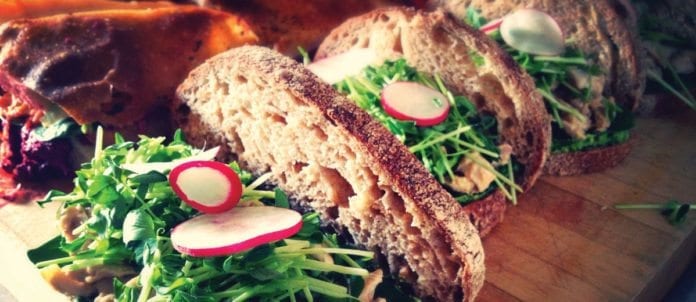We hear a lot these days about how the food we eat impacts our health. The World Health Organization estimates up to 66,000 Canadians die each year due to nutrition-related diseases, including heart disease, diabetes and cancer, with obesity, among adults and children, becoming a concern.
We’re all responsible for what we eat, whether at home or while dining out, but with more meals than ever eaten out, chefs and restaurateurs are trying to help, creating healthier menu options while considering everything from sodium and saturated fat to gluten when designing their menus.
In fact, according to Restaurants Canada’s (formerly the CRFA) 2014 Chef Survey, smaller portions, healthy kids’ meals as well as vegan and meatless entrées are all on the radar — with gluten-free and allergy-conscious foods topping the list of hot culinary trends.
With the Ontario government’s promised menu labelling bill in the offing, and British Columbia promoting its voluntary Informed Dining program, restaurants may soon be required to list calories on their menus or at least provide more nutritional information.
But even without such legislation, healthy food labelling is already popular on Canadian restaurant menus, says Kelly Weikel of the Chicago-based research firm, Technomic. While “low fat” or “heart healthy” were once used to highlight healthy choices, today’s most popular health claim, on both full-service and limited-serve menus, is the “gluten-free,” claim, seen nearly 10 times more often than the low fat claim, with “vegetarian” running a close second. “Consumers continue to look for balanced diets and to trend away from … traditional health claims like low fat and low salt and toward more health-halo attributes like vegetarian and gluten-free, [which they] perceive as healthy,” says Weikel.
That’s the focus at Vaughan, Ont.-based Milestones Grill + Bar where the website provides detailed nutritional breakdowns, and menus include icons for gluten-free, vegetarian and low-sodium dishes. “Milestones has always been about in-house cooking from scratch and catering to customer requests, so we’ve always made a fairly conscious effort to follow the eating trend curve,” says Jason Rosso, corporate executive chef. “We want to offer food people can come in and eat on a regular basis.”
With an executive chef in each of the chain’s 53 restaurants across Canada, Milestones doesn’t rely on pre-packaged soups or sauces that can be high in sodium, fat and sugar. And, since on-site chefs can cook from scratch, customers with allergies — to foods such as shellfish, dairy or gluten — are served a meal that is safe for consumption. “We take it very seriously,” Rosso says, noting “allergy plates” are marked and individually handled at “clean stations” so cross-contamination is never an issue. Allergies and health are also considerations as menus are revised. “We’re looking at taking two of our bestselling pasta dishes — Grilled Chicken Penne Asiago ($18) and Grilled Chicken Pesto Fettucini ($17) — and using gluten-free corn pasta,” says Rosso. “So dishes don’t change but there are healthier or gluten-free options.”
A new sharable guacamole made with roasted chickpeas and piripiri will also be on Milestones’ new menu this summer, while popular dishes, such as the signature California Spring Salad with goat cheese and strawberries ($14) and Chopped Salad with chicken, avocado and chickpeas ($16), are staples. “I’ve reworked the Asian steak salad ($19), which was quite sweet and high in carbohydrates, with a wasabi, black sesame and grapeseed oil dressing,” says Rosso. “There’s still a good amount of decadence on the menu but more of a healthy tilt.
” With so many “special diets” becoming mainstream, from gluten-free and vegan to lactose-free, low-carb and Paleo diets, it’s hard to keep ahead of the curve. The “clean eating” trend is creating demand for plant-focused food and, in Vancouver, several new restaurants specialize in high-end vegetarian and “vegetable-forward” cuisine, with plates that focus on everything but traditional proteins. At Burdock & Co., chef Andrea Carlson (former executive chef at upscale Bishop’s) takes individual vegetables to new levels — plant-based plates on her sharable menu include Celeriac and Potato ‘Ragout’ with goat curd, mustard greens and smoked hazelnuts ($14), as well as Roasted Squash and Barley Miso Ramen with spinach and smoked chili oil ($13).
At The Acorn restaurant, carnivores dine alongside strict vegans — none missing the meat in chef Brian Skinner’s creative vegetable-forward food. Raw beet “ravioli” stuffed with a “cheese” of puréed macadamia ($10) ticks the gluten-free, vegan and raw food boxes, while beer-battered halloumi cheese with zucchini pancake, smashed peas and mint yogurt ($19) is reminiscent of fish and chips.
Named one of Canada’s top new restaurants in 2013 by EnRoute magazine, Acorn’s plates are beautiful and healthy, without a whiff of denial. “We wanted to do beautiful vegetarian cuisine — no meat substitutes or fake food — [and] celebrate the beauty of vegetables,” says Shira Blustein, co-owner, Acorn.
It’s the same story at The Parker, where chef Curtis Luk serves mains such as Sunflower Seed Risotto, stuffed onion, brussels sprouts and sunchokes ($17) and Roasted Root Sofrito with pistachio crumble and spinach emulsion ($16).
In Victoria, Rebar paved the way for vegetarian dining 25 years ago, and now chef Heather Cunliffe is breaking new ground. After studies at the Tree of Life Rejuvenation Centre in Arizona, Cunliffe opened Café Bliss, a small space dedicated to raw and live food. She’s built a loyal following for her healthy raw juices, tonics and smoothies, raw food “breads” and cakes, including a raw chocolate hazelnut torte and key lime pie.“I was really inspired and started to eat a 100-per-cent raw-food diet,” says Cunliffe, who also published many of her raw food recipes in the cookbook, Blissful.
Last year, with her brother Joe, Cunliffe opened Be Love, a downtown restaurant that focuses on wheat-free vegan dining, even gluten-free beer, wine and cocktails “reflecting our philosophy of love, sustainability and nourishment.” “At Be Love there’s no meat or dairy, but we do both raw and cooked dishes,” says Cunliffe, who no longer advocates a purely raw-food lifestyle. “My food is about providing an option, to bring people into balance with their bodies.”
Health is the focus for Toronto chef Eddie Chan’s Bolt Fresh Bar, too. The small vegetarian spot specializes in healthy quick-service and diners can design their own salads or whole grain-based bowls, adding healing foods from açaí berries and kale to Peruvian lucuma (a low glycemic sweetener), sprouted beans, kelp and kimchi. It’s all designed for clean, detoxifying and nutrient-dense dining on the run. Like Cunliffe’s raw zucchini ‘bacon’ ZLT ($15) or Carmanah Bowl of quinoa with sautéed wild nettles, shiitake mushrooms and house sauerkraut ($14), it’s different than the grilled chicken wraps and fruit smoothies that quick-service restaurants promote as health food. But it’s moving in the same direction.
At Wendy’s, SVP Paul Hilder says the company has always strived to offer healthy options. “Chili was always on the menu, and we had a salad bar 30 years ago,” says Hilder, noting Wendy’s new Asian Cashew Chicken, BBQ Ranch Chicken and Taco Supreme salads (all $8.49 full or $4.99 half) boost their salad choices to five. “We most recently launched new salads, but we’ve always tried to appeal to a diverse audience looking for options.”
At Wendy’s, side-dish choices range from fries to garden salads, chili and baked potatoes. Drill down into their website, and you’ll find nutritional information for every dish. “Consumers are becoming more aware of what they eat,” says Hilder. “We’re starting to see more questions about gluten-free options and sodium, too.”
Wendy’s is promoting its three new salads across all media, from TV to Facebook, with a free bilingual nutrition app for smartphones. The Asian Cashew Chicken Salad is both the most popular and healthiest at 370 calories and 14 g of fat. “We haven’t really seen a shift from our core product, but new people are coming,” Hilder says. “That’s our ultimate goal — to have customers come to Wendy’s more often.”
Whether healthful menu options will continue to win sales remains to be seen, but clean, green food is a popular topic at the table.“We see a lot of people who want a healthy way to eat, and more vegetarian and vegetable-forward restaurants are popping up,” says Burdock & Co.’s Carlson. “Attitudes are shifting.”




















